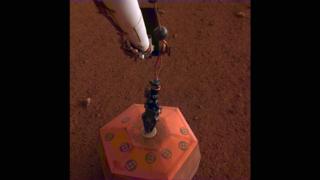Nasa lander ‘detects first Marsquake’

 Image copyright NASA/JPL
Image copyright NASA/JPL The American space agency’s InSight lander appears to have detected its first seismic event on Mars.
The faint rumble was picked up by the probe’s sensors on 6 April – the 128th Martian day, or sol, of the mission.
It is the first seismic signal detected on the surface of a planetary body other than the Earth and its Moon.
Scientists say the source for this “Marsquake” could either be movement in a crack inside the planet or the shaking from a meteorite impact.
Nasa’s InSight probe touched down on the Red Planet in November last year.
It aims to identify multiple quakes, to help build a clearer picture of Mars’ interior structure.
Researchers can then compare this with Earth’s internal rock layering, to learn something new about the different ways in which these two worlds have evolved through the aeons.
Interestingly, InSight’s scientists say the character of the rumble reminds them very much of the type of data the Apollo sensors gathered on the lunar surface.
The vibrations picked up by InSight’s sensors are made audible in this video, and record three different types of signal. (1) The wind on Mars; (2) the reported 6 April event; and (3) the movement of the probe’s robot arm as it takes photos.
Astronauts installed five seismometers that measured thousands of quakes while operating on the Moon between 1969 and 1977.
InSight’s seismometer system incorporates French (low-frequency) and British (high-frequency) sensors. Known as the Seismic Experiment for Interior Structure (SEIS), the instrument was lifted on to the Martian surface by the probe’s robotic arm on 20 December.
Both parts of the system observed the 6 April signal, although it wasn’t possible to extract any information to make a more definitive statement about the likely source or the distance from the probe to the event.
“It’s probably only a Magnitude 1 to 2 event, perhaps within 100km or so. There are a lot of uncertainties on that, but that’s what it’s looking like,” said Prof Tom Pike, who leads the British side of the seismometer package.
On Earth, very few people would notice a Magnitude 1 to 2 event.
The team is investigating three other signals picked up only by the low-frequency sensors – on 14 March (Sol 105), 10 April (Sol 132) and 11 April (Sol 133). However, these were even smaller than the Sol 128 event, and the InSight scientists do not have the confidence yet to claim them as real seismic events.
The probe’s prime mission is set to run for two Earth years – a little more than one Martian year.
Given the time taken to make this first detection, it might suggest InSight should record another dozen or so seismic signals in the initial operating period, explained Prof Pike.
“When you’ve got one, you don’t know whether you were just lucky, but when we see two or three we will have a better idea,” the Imperial College London researcher told BBC News.
“Of course, if the other three are confirmed then we could be looking at quite a large number of detections over the next two years.”


